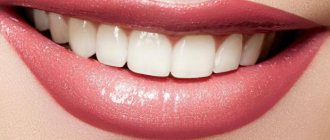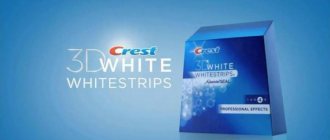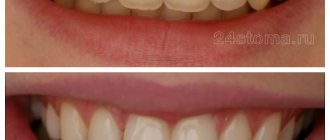From this article you will learn:
- whitening strips – reviews, before and after photos,
- differences between Crest and Blendamed strips,
- price of strips in a pharmacy for 2022.
The article was written by a dentist with more than 19 years of experience.
Whitening strips are designed for chemical teeth whitening at home. The whitening effect is achieved due to hydrogen peroxide, which is applied in the form of a gel to the inner surface of the strips. Their advantages include ease of use, good effectiveness, and a much more affordable price compared to whitening at the dentist.
In Russia, the most well-represented strips for teeth whitening are produced under the brands “Crest 3D White” and “Blendamed 3D White Luxe”. This creates the illusion of choice, but in fact both brands are owned by the same (USA). Compared to Blendamed strips, Crest strips have a higher concentration of hydrogen peroxide.
Teeth whitening strips Crest 3D White and Blendamed 3D White Luxe are good marketing products. You don't have to go to the dentist. It is much cheaper than in the clinic. But why then are the reviews of a fairly large part of patients on teeth whitening strips still far from enthusiastic? In this article we will talk not only about the undoubted advantages of their use, but also the problems that you may encounter.
How do teeth whitening strips work?
Most home teeth whitening systems contain hydrogen peroxide or carbamide peroxide as an active ingredient. Different types of Crest 3D White strips contain different concentrations of hydrogen peroxide - from 9.5 to 14% (we will discuss each type of Crest strips in detail below), and Blendamed 3D White Luxe whitening strips contain 5.25% hydrogen peroxide.
Solutions of hydrogen peroxide and carbamide peroxide are capable of penetrating deeply into tooth tissue with prolonged exposure - to the entire thickness of enamel and dentin. Having penetrated inside, these peroxide compounds decompose there to form free radicals (active oxygen). It is free radicals that lead to the destruction of molecules of chromogenic substances, which give teeth pigmentation.
However, free radicals are not stable compounds and quickly decompose. Therefore, to obtain a whitening effect, hydrogen peroxide must be in contact with the teeth for a sufficiently long time, and it is also necessary to maintain a sufficient concentration. The lower the concentration of hydrogen peroxide in the strips, the longer they will have to be used to get the desired effect.
How to Choose the Best Whitening Plates
Before purchasing a kit, you should make an appointment with your dentist and undergo a preventive examination. The doctor will assess the condition of your enamel and recommend the most suitable remedy specifically for your case. When choosing strips, dental experts advise considering the following characteristics:
- the concentration of the active component - the higher it is, the faster and more noticeable the result will be, however, the potential danger to teeth will also be higher,
- principle of operation, duration of one session and the course as a whole - choose based on your own preferences,
- packaging tightness,
- company and country of origin,
- best before date,
- price category.
Today on the Internet you can find a lot of real reviews about a variety of brands of whitening strips, and on thematic forums you can always discuss certain kits with those who have already tested their effectiveness and safety from their own experience. However, in the question of which product is best for you, the recommendation of a specialist should be decisive.
Whitening strips Crest 3D White –
Crest strips for teeth whitening (Crest 3D White) - available in 6 different versions. They differ in different concentrations of hydrogen peroxide, the number of strips in the package, and the exposure time of the strips on the teeth. One of the strip options even has a special light source, which apparently should give the consumer the illusion that this product is similar to professional “laser” whitening systems.
But what's really important is that different types of strips hold onto the teeth differently. Some of them can slip on the teeth and do not stick well. When choosing Crest strips, pay attention to the fact that they contain Advanced Seal® technology (allows the strips to adhere firmly to the teeth and not slip on them). Otherwise, the strips will peel off and there will be no close contact of the whitening gel with the enamel surface.
If you have an uneven dentition/crowded teeth, or a pronounced inclination of some teeth, the FlexFit® technology will allow you to achieve good adaptation of the strips to the surfaces of all teeth. In this case, the strips will be slightly elastic (stretch), which will allow them to better adapt to uneven tooth surfaces or uneven dentition shapes. Only Crest 3D White “Supreme FlexFit” strips have this technology. If the strips do not adhere tightly to some surfaces, then the teeth in these areas will remain dark.
What are the strips and what is included in the kit?
The width of the teeth cleaning strip is sufficient to cover the visible and hidden sides of one row of teeth. In standard packaging there are usually two types of such plates - a shortened one for the lower jaw and an elongated one for the upper jaw. On one side, the overlay is treated with a special brightening gel designed for direct contact with the enamel surface. The composition is completely harmless, but only if there are no problems with teeth or inflammatory dental diseases. Therefore, before using the method, you must visit your dentist and make sure that you have no contraindications to the use of strips.
The photo shows teeth whitening strips
Whitening strips: reviews
Let’s say right away that the Crest 3D White “Vivid” strips and especially the Blendamed 3D White Luxe will receive the least good reviews. These versions of the strips do not hold onto the teeth well enough, they slide over them, and if salivation is quite active, it will not be possible to fix them well on the teeth at all, as a result of which there will be no necessary tight contact of the whitening gel with the enamel.
The reviews for White Light teeth whitening are satisfactory. In professional whitening techniques, light sources are used to accelerate the breakdown of hydrogen peroxide in the whitening gel into free radicals, and exposure to light is carried out not after, but during the procedure. In Crest 3D White “With Light” strips, the light is used for 10 minutes after the end of the procedure and, thus, it is not intended to activate the whitening gel.
The portable White Light lamp does not have its own whitening effect, because it is a source of light waves in the “blue” range, and only light waves in the ultraviolet range have a slight whitening effect. Therefore, we believe that the light source in these strips is purely a marketing ploy to make this procedure look like professional laser whitening. This allows us to sell 10 sets of Crest White Light strips - at the price of 20-40 sets of similar sets.
Which Crest strips are better –
We consider the best option for strips to be Crest “Supreme FlexFit”, which is tightly fixed to the teeth and allows the strips to adapt well even in areas of uneven teeth. In 2nd place we would put the Crest “Professional Effects” strips. But we do not recommend using Crest “Supreme Professional” strips with 14% hydrogen peroxide. The fact is that even if the strip does not come into contact with the gums, hydrogen peroxide always gets into the oral fluid due to the contact of the gel with saliva. Therefore, when using a 14% concentration, gum burns and a burning sensation in the throat will be practically guaranteed.
Please note that different versions of strips with the same concentration of hydrogen peroxide of 10% are recommended for different times. Moreover, where the exposure of the strips is 30 minutes, the whitening goes by 3-4 tones, and where the exposure is 60 minutes, by about 6-8 tones. In our opinion, the manufacturer deliberately recommends using essentially the same strips - for different times, so that it does not turn out that cheaper strips will be as effective as more expensive ones.
Crest Professional Effects Strips – Before and After
Crest Vivid strips – before and after photos
CONCLUSIONS: in general, the effectiveness of whitening strips can be very high, and under certain favorable conditions (straight teeth, absence of pigment plaque and dental deposits on the teeth, etc.) - the effect of such home therapy can be practically no different from the result of professional whitening in dentist However, before you buy teeth whitening strips, also read about their disadvantages, which we will tell you about later.
What types of whitening strips are there?
The range of brightening products for home whitening is constantly expanding, and today you can purchase a kit for a snow-white smile in almost every pharmacy. This standard set usually includes 2 films - for each jaw. It should be noted right away that this technique is designed to treat only the smile zone, so it is unlikely that it will be possible to lighten the back teeth.
So, currently on pharmacy shelves you can find the following types of whitening strips:
- delicate - aimed at people with increased sensitivity of enamel and, accordingly, its acute susceptibility to temperature changes in food and drinks, sour, sweet foods,
- standard is the best option for people without severe dental problems, with healthy teeth and gums,
- enhanced action - used mainly for emergency elimination of bacterial plaque and urgent lightening of enamel. Such kits contain an activator with a high concentration of the active substance,
- supporting – indicated to consolidate and prolong the achieved effect.
There are also certain types of strips that completely dissolve - there is no need to remove them at the end of the session. However, more often than not, manufacturers still produce strips with a removable film designed to protect the mucous membrane from chemical irritation. There are also options for quick and long exposure. The first offer an almost instant effect, however, the side effects of such bleaching can be much greater.
Side effects and disadvantages of whitening strips –
Reviews for whitening strips on all sites are written as carbon copies; the texts of the reviews are more like advertising brochures that praise the strips from different angles, keeping silent about the shortcomings. And although home whitening techniques can indeed be very effective, teeth whitening strips still have significant disadvantages...
They do not whiten fillings and crowns -
Chemical whitening allows you to lighten only the tooth tissue. Fillings, veneers, and any types of artificial crowns cannot be bleached. This means that if you have fillings or crowns on one or more teeth, then after whitening they will look even darker against the background of the whitened enamel of the remaining teeth (Fig. 14). Whitening in such situations will mean the need to subsequently replace veneers, crowns and fillings with lighter shades.
It should also be taken into account that after a few months, the teeth will gradually begin to darken again (the speed of teeth darkening after whitening is related to your habits, for example, smoking, the frequency of drinking coloring drinks and foods). This may mean the need for either new replacement fillings, veneers or crowns, or ongoing periodic courses of home whitening.
Uneven whitening –
Reviews of teeth whitening strips are often negative due to the fact that although the front surfaces of the teeth become much whiter, they remain dark in the interdental spaces. This creates a sharp contrast between dark and light, and the interdental spaces end up looking like black triangles (Fig. 15). Why is this happening...
Firstly, the thickness of the whitening gel on the inner surfaces of the strips is only about 0.2 mm. At the same time, the surface of the teeth is not absolutely smooth, and therefore, when adapting the strips to the teeth, the whitening gel simply does not penetrate sufficiently into the interdental spaces. The second reason lies in the uneven position of the teeth, for example, when they are crowded. In this case, adapting the whitening strip to teeth located deeper (lingually) will be very false, which will mean poor contact of the whitening gel with these teeth.
Thirdly, the problem is that most people use Blendamed or Crest whitening strips without first removing plaque and plaque from the dentist. The fact is that the surfaces of teeth covered with pigment plaque whiten a priori much worse, because coating on these areas will prevent hydrogen peroxide from penetrating into them. And therefore the surface of the teeth in these areas will remain dark.
Pain and sensitivity of teeth -
Clinical studies by Cooperetall in 1992 showed that the penetration of free radicals into the dental pulp occurs within 15 minutes after applying 3% hydrogen peroxide gel to tooth enamel. It is this process, as well as a certain degree of demineralization of enamel and dentin, that leads to the development of increased sensitivity of teeth after whitening.
Sensitivity is expressed in the appearance of pain to thermal stimuli (heat, cold). And the longer the bleaching course continues and/or the higher the concentration of hydrogen peroxide, the stronger the sensitivity will be every day. In this case, you can start using special pastes to relieve sensitivity, or reduce the exposure time of the strips on the teeth, or start using them every other time. And after completing the whitening course, it is worth taking a course of remineralization or fluoridation of teeth.
Important: if you have erosions, carious lesions, deep wedge-shaped defects with exposed dentin on your teeth, then you can predict a very high rate of hydrogen peroxide entering the dental pulp (neurovascular bundle) - with the development of severe pain, and even a chemical burn of the pulp , which may then even require removal of the nerve from the tooth. Therefore, caries and wedge-shaped defects must be cured before using whitening strips (24stoma.ru).
Burns and inflammation of the gums, throat irritation -
About half of all patients also complain of sore gums after using whitening strips. The fact is that the whitening strips have a straight shape - in contrast to the gum line, and therefore, when applying the strips to the teeth, they always come into contact with the interdental gingival papillae. As we said above, the strips are coated with a gel with hydrogen peroxide with a concentration of 5.25 to 14% (10% on average), which contributes to the development of a chemical burn of the gums.
Inflammation and burn of gums after whitening –
But gel with hydrogen peroxide can cause harm not only to the gums. The whitening gel is located in the moist environment of the oral cavity, so some of the hydrogen peroxide necessarily gets into the saliva. This means that hydrogen peroxide will affect not only the interdental papillae, but also other areas of the gums and the tongue. In addition, when you swallow saliva, hydrogen peroxide will contact the mucous membrane of the throat, causing irritation. To reduce such side effects, always rinse your mouth after removing strips, reduce exposure time, or use strips with a lower concentration.
White spots on teeth -
When you remove the whitening strips, you can often notice white spots appearing on the enamel. In most cases this is not a problem, because... occurs due to drying out of the enamel area due to the fact that the strips isolate the front surface of the teeth from contact with saliva. Such stains disappear after a few hours (after the enamel is saturated with moisture).
However, if you use low-quality whitening strips (the whitening gel will have an acidic pH), you can end up with chalky white spots on your enamel that will last a lifetime. This can also happen if the enamel of your teeth has poor resistance to chemical and mechanical factors, which occurs against the background of demineralization of the enamel. Generalization means that your enamel contains very little calcium, i.e. as if porous.
If there are white chalky spots on your teeth even before whitening, then this is one of the signs of enamel demineralization, which means that any type of chemical whitening will be contraindicated for you. The use of chemical bleaching against the background of enamel demineralization will lead to an even greater loss of calcium from dental tissues, which will increase the risk of tooth decay (as a result of increased abrasion or the development of caries).
How to use whitening strips at home
This method is really good and effective. However, the main condition for achieving success is to strictly follow the instructions for using the product. Otherwise, all your actions may turn out to be not only useless, but even dangerous for the health of enamel and teeth. So, below is a universal sequence for home whitening:
- First, you should open the sealed package and remove the records from there,
- take one pad and remove the transparent film from it,
- standing in front of the mirror, apply the plate with the treated side to the front surface of the row so that it does not touch the gum - first brush your teeth with a brush and toothpaste, rinse your mouth thoroughly and blot the enamel with a dry paper towel,
- make sure that the gel is evenly distributed along the row, penetrates into the spaces between the teeth,
- There should be a free section of the plate above the teeth - it needs to be tucked in and applied to the inside of the teeth,
- fix the pad on the second jaw in the same way,
- You need to keep the plate on your teeth for as long as indicated in the instructions, and in no case longer. After the specified period, the pad must be removed and disposed of - it is intended for one-time use,
- After this, you should thoroughly brush your teeth and rinse your mouth with water.
Proper use of strips is the key to health
While the strips are in the mouth, you cannot eat, drink, or talk, unless otherwise specified in the instructions. The procedure should be carried out once a day, preferably at the same time.
How harmful are whitening strips to tooth enamel?
Hydrogen peroxide, with prolonged exposure, penetrates not only into the entire depth of enamel and dentin, but even into the dental pulp (neurovascular bundle). There are numerous studies that confirm the slight negative effect of peroxide compounds on tooth tissue...
- Chemical bleaching with hydrogen peroxide can negatively affect the surface texture and shine of the enamel if the gel on the surface of the whitening strips has an acidic pH. In this case, erosions, chalky spots with a matte surface may appear on the enamel surface, and loss of enamel shine may occur. High-quality whitening strips contain sodium hydroxide or its analogues (make the pH neutral).
- Clinical studies by Sighiand Denry 1992 and McCracken et al. 1996 - showed that chemical bleaching leads to a slight decrease in the strength of enamel and its wear resistance to abrasives and chemicals. This occurs due to demineralization of enamel and dentin, i.e. their loss of calcium. Studies have confirmed that the preventive use of a course of fluoride after the end of a whitening course can significantly improve the situation.
- But the most important thing is that chemical whitening disrupts the bond between tooth dentin and filling materials (light composites, glass ionomer cements). This is confirmed by studies by Della Bona et al. 1992, “Tiunsakeretall” 1990, “Titleyetall” 1991. As a result, the marginal fit of the filling to the tooth tissue deteriorates, which can lead to the development of caries at the filling/tooth interface, as well as the need to replace fillings.
Conclusions: whitening strips with a concentration of hydrogen peroxide up to 10% inclusive are a fairly safe product for home use that does not cause critical changes in the teeth (provided that the product has a slightly alkaline pH, there are no carious lesions on the teeth, and also when good oral hygiene). A slight decrease in the degree of mineralization of enamel and dentin can be compensated for by subsequent courses of remineralization and fluoridation of tooth enamel.
A snow-white smile at home – a fresh review of popular whitening strips
Tooth enamel turns yellow and darkens under the influence of various factors: consumption of food and drinks with intense coloring pigments, smoking, addiction to coffee, poor oral hygiene and the natural processes of aging of the body. Fortunately, modern dentistry has everything necessary to be able to return your smile to its natural whiteness or even make it even more beautiful. One of the home methods for lightening enamel involves the use of special teeth whitening strips. Today we’ll talk in detail about how to use strips correctly, find out whether they are harmful, and also look at a fresh review of popular kits.
Whitening strips: application diagram
Manufacturers of whitening strips recommend not brushing your teeth before using them, arguing that in this case the bacterial film on the surface of the gums will protect them from excessive irritation. This makes a certain sense, but this does not mean at all that you should have food residues in the spaces between your teeth, and traces of soft plaque at the necks of your teeth. Please note that the interdental spaces must be cleaned with dental floss.
1) Preparing to apply the strips - To improve the adherence of the strips to the teeth, you can remove excess saliva from the front surfaces of the teeth using a dry gauze pad.
2) Applying strips - next, take a wider and shorter strip and, having separated it from the protective layer, carefully, without much pressure, apply it with the gel side to the front surface of the lower teeth. The bottom edge of the strip should run along the gum line. After you are sure that the strip is positioned correctly, press it against your teeth for 2-3 seconds.
Then fold the upper edge of the strip over the cutting edge of the lower front teeth and also press for 2-3 seconds. Fix the second (narrower and longer strip) in the same way - on the teeth of the upper jaw. The exposure time of the strips on the teeth is usually from 30 to 60 minutes, according to the type of strips and instructions.
What the overlay of stripes looks like: video
3) Clean your hands – when applying the strips, you will definitely get the hydrogen peroxide gel on your fingertips. The smallest thing that can happen is that your fingertips turn white. It will be much worse if you rub your face with unwashed hands or get the gel into your eyes, or if the gel gets from your hands onto the fur or skin of pets. Also, very often patients spoil their clothes, because... Hydrogen peroxide will permanently lighten areas of tissue where it gets in contact.
4) Additional recommendations - as we said above: hydrogen peroxide will in any case get from the whitening gel on the strips into the oral fluid. To avoid unnecessary irritation of the gums and throat, it is advisable to periodically spit out saliva without swallowing it. This process is not very pleasant, so try to use the strips at times when you are not actively salivating (i.e. not on an empty stomach). A small amount of saliva can be swallowed without fear of the above side effects.
If you begin to feel a burning sensation in your gums or throat, immediately remove the strips and rinse the oral mucosa with plain water. Perhaps next time you will need to reduce the time for fixing the strips on your teeth, or start doing them every other time (this will simply lengthen the whitening course), or purchase strips with a lower concentration of hydrogen peroxide. And lastly, after completing such a home whitening course, always have your enamel fluoridated at the dentist.
Also, during the whitening course, you should give up highly abrasive toothpastes to compensate for the temporary decrease in enamel wear resistance, as well as drinks and foods with a high acid content (wine, fruit juices...), as well as smoking. If you use an electric toothbrush for hygiene, then for some time it is better to use either the attachment for sensitive teeth or the “gentle brushing” mode without pulsating movements.
Types of kits - the best whitening strips
One of the most popular, and therefore the best, manufacturers of whitening strips is (Crest), which, in turn, is part of the Procter & Gamble USA group of companies. This brand produces a whole series of Crest 3D White kits, and each copy is designed for use in various conditions, including for sensitive teeth. Let's look at the main types of sets in more detail.
Professional Effects
An excellent product, the effectiveness of which is confirmed by numerous laudatory reviews. The full course makes it possible to obtain results comparable to the effect of professional in-office whitening. At the same time, the manufacturer guarantees a gentle effect on dental tissues, protection from injury and destruction. The course includes 20 sessions and promises lightening of up to 4 tones. In theory, the effect should last up to one and a half years, but this is only subject to perfect adherence to all recommendations, complete cessation of smoking, coffee and products containing dyes. The cost of packaging is approximately 3,500 rubles.
Supreme FlexFit
In this set, the manufacturer has implemented its new technology, which ensures stronger adhesion of the plate to the enamel and penetration of the active components of the composition into the most inaccessible places. According to the manufacturer, FlexFit is suitable even for cases where there is increased sensitivity. The product allows you to lighten your teeth by as much as 6 tones, and the price of a package is on average 4,500 rubles.
Advanced Vivid
The plates are very tightly and firmly fixed to the teeth, thanks to which the person is able to speak and drink freely during the procedure. One package is designed for a two-week course - every day you need to leave the pads in your mouth for half an hour. The effect should be noticeable already on the fourth day, and the final result can last more than a year. The cost of the set is 3200-3500 rubles.
Glamorous White
In a couple of weeks of systematic use, it is possible to achieve a color change of 4 tones. The effect of the gel becomes noticeable already on the third day of the course - it is enough to apply the strips to the teeth daily for 30 minutes. The manufacturer promises strong adhesion of the lining to the enamel to prevent it from moving and getting the gel on the mucous membrane. The stated duration of the effect is 18 months, and such whitening costs 3,500 rubles.
Gentle Routine
An option for hyperesthesia, in which any other methods of lightening it are contraindicated. The whitening agent is characterized by a low concentration of peroxide, which is quite enough to remove plaque and pigmentation, but without the risk of damaging the enamel. The course involves 28 days, and the possible effect is 3 tones. The cost of the set is about 3000 rubles.
Classic Vivid
The optimal choice for those who are just trying home whitening options. The course lasts 10 days, during which each day you need to apply the overlays to the rows for half an hour. In a toga, you can change the shade by 3 tones, and the achieved effect lasts up to a year. The product also provides for cases of hyperesthesia, costs 2700-3000 rubles.
Minute Touch-Up
This kit is used as a maintenance measure after using other, more intense whitening methods, including plates. Six months to a year after the procedure, the enamel begins to gradually fade. To prevent it from completely darkening, you can resort to the help of just such strips. Just 5 minutes a day is enough to maintain the previously achieved results. The enamel can be lightened by 3 tones, and the cost of the package is about 3,000 rubles.
Contraindications for bleaching –
The development of allergic reactions to the whitening strips Cross and Blendamed is possible. If you are allergic to any of the components, you must avoid using them. There are also a number of diseases and conditions in which the use of whitening strips will be contraindicated.
Contraindications to whitening strips –
- presence of enamel erosions,
- the presence of areas of enamel demineralization (in the form of white chalky spots),
- the presence of untreated caries,
- with the frequent appearance of new carious lesions,
- the presence of deep wedge-shaped defects with exposure of dentin,
- during pregnancy and breastfeeding,
- for diabetes mellitus,
- You must stop smoking for the entire whitening period.
- with severe degrees of fluorosis, enamel hypoplasia or tetracycline staining,
- in adolescents under 18 years of age (at this age there is still a large volume of pulp chambers, which can lead to a chemical burn of the pulp and the need for tooth depulpation).
Basic precautions when using records
Despite the safety of such bleaching, it should not be done too often. You must first carefully study the instructions and how to use the strips. To do everything according to the rules, experts in the field of aesthetic dentistry strongly recommend adopting the following tips:
- to achieve a more pronounced effect, you can additionally use a special whitening paste - such a course should be limited to a certain time frame (2 weeks), otherwise the enamel can be seriously injured,
- within a couple of hours after the session, you need to give up any coloring food and drinks, abstain from cigarettes,
- at least during the course, you need to carefully monitor the temperature of the food and avoid sharp contrasts. Increased sensitivity may appear at the very beginning of whitening, but this is only a temporary phenomenon.
- in the presence of dental diseases, including inflammatory ones, first you need to cure everything, and only after that you can begin lightening sessions,
- Do not be alarmed if you swallow a little of the gel, but you should avoid getting a significant amount of the composition into your stomach, as this can lead to intestinal upset.
After the procedure, it is advisable to eat non-coloring foods.
As mentioned above, before using the strips, you should consult your dentist. If during the process you feel obvious discomfort, immediately remove the plates and rinse your mouth with water. Regarding further use of the kit, consult a specialist.
How they work
When placing shelves on tooth enamel, hydrogen peroxide begins to actively release oxygen ions, which, penetrating deep into the enamel tissue, destroy organic pigment and lighten the tooth surface. Gels for use by professionals contain increased amounts of hydrogen peroxide. Additionally, to enhance the effect, they are exposed to laser or light. The effect of procedures performed by a dentist occurs after just two procedures.
Whitening strip products are intended solely to whiten natural tooth enamel and do not work on dentures or fillings placed in the mouth. Therefore, if they are installed where they are visible from the outside, and have a color different from the color of the whitened tooth surface, they will stand out from the rest of the teeth. This should be taken into account before carrying out whitening procedures.
Efficiency
One of the advantages of whitening strips is their effectiveness compared to other means of achieving white teeth. They are able to change the color of the enamel by 3-4 tones compared to the original color. The whitening result becomes noticeable already on the 3rd day of the procedure, and the desired result is achieved in just a week. Much depends on the amount of hydrogen peroxide contained in the active layer. Its concentration in strips for home use is not higher than 20%.
Different manufacturers have different active layer compositions, and even the same company may have differences in hydrogen peroxide content. The whitening effect depends on the proportion of the active substance and the duration of the procedures. For example, the effect of enamel whitening from exposure to strips containing 6% hydrogen peroxide for 4 days will be approximately the same as when whitening strips containing 12% peroxide and their effect for 2 days.
How to use
When carrying out the procedures yourself, you need to carefully read the instructions and check the composition to make sure that it does not contain components to which you may be allergic. Then you need to remove the film protecting the gel and apply the strip with the active side to the surface of the enamel of the teeth for which it is intended. It is better to apply the application in front of a mirror.
Using light finger pressure, gently straighten the strip, eliminating all folds and voids. The exposure time of the strips on the tooth surface should be from 5 to 30 minutes, it all depends on the manufacturer of the products. The procedure must be carried out at least once a day. Using the strips twice a day, 12 hours apart, may speed up the effect. It is unacceptable to reuse strips that have been used. The procedure with one strip should also not take longer than the recommended time, otherwise the enamel may be damaged.
You should not drink, eat or sleep with the strips attached, as they may come off the surface of the enamel and the gel will enter the stomach. After the procedure, carefully remove the plate from your mouth, rinse it with water and brush your teeth with toothpaste. The course of procedures is about 7 days. During this time, you should not eat food with a dye, such as tea and coffee, and you should not smoke. If these rules are not followed, the opposite effect may occur. It is not recommended to brush your teeth with toothpaste before the procedure.









